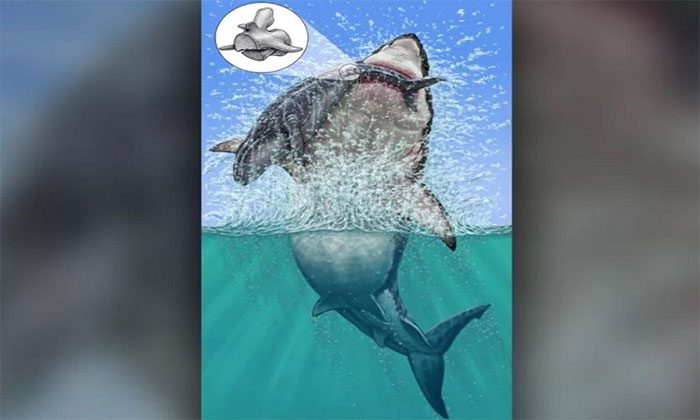Researchers Find Evidence of an Ancient Whale Surviving Weeks After Being Bitten by a Megalodon Shark.
Approximately 15 million years ago, in warm waters covering what is now southern Maryland, a gigantic megalodon shark (Otodus megalodon), towering as high as a five-story building, lunged to attack a whale near the water’s surface, creating a massive splash. It clamped its jaws, filled with 250 sharp teeth, into the whale’s midsection. As they struggled in a bloody battle, the force of the attack warped the whale’s spine and caused bone fractures due to compression.

Reconstruction of Otodus megalodon attacking a whale. (Photo: Clarence (Shoe) Schumaker).
This scenario is what scientists envision after examining two fractured vertebrae from the whale and a megalodon tooth found in close proximity at the Calvert Cliffs in Maryland, a site dated to the Miocene epoch (5.3 to 23 million years ago). The research team, led by Stephen J. Godfrey, a paleontology curator at the Calvert Marine Museum, described the whale’s injuries and the cause of the wounds in a paper published on August 25 in the journal Palaeontologia Electronica.
The remaining bone fragment from the whale, measuring 4 meters long and dating back 15 million years, was first discovered by Mike Ellwood, a fossil collector and volunteer at the Calvert Marine Museum. However, it was not possible to determine whether the specimen belonged to a toothed whale, a baleen whale, or even a large dolphin.
Godfrey believes he can learn more about the specimen by examining the inside of the damaged vertebrae using CT imaging. A local hospital offered to assist in assessing the specimen through modern medical imaging techniques. The scan revealed clear signs of bone fractures due to compression that were immediately recognizable.
The research team also discovered a membrane surrounding the bone called a periosteum, which produces new bone after an injury. Regardless of whether this bone formation occurred to heal the injury as in humans or was the result of infection or arthritis, the development of new bone demonstrates that the whale survived for several weeks after the fracture.
While this hypothesis is intriguing, many other factors could have caused the whale’s vertebrae to break millions of years ago. In addition to the megalodon, its close relatives such as Otodus chubutensis, the false mako shark (Parotodus benedenii), the Miocene white shark (Carcharodon hastalis), or even the sperm whale macroraptor (Physeteroidea) could have inflicted similar injuries. It is also possible that the whale ingested toxic algae and experienced violent seizures that led to the spinal fracture.
However, Godfrey argues that the megalodon attack is the most plausible explanation based on the scale of the injuries. A vertebra bent inward due to the force from other vertebrae colliding against it. This is unlikely to occur from a seizure. Notably, the megalodon tooth was found along the spine. Detailed examination revealed that the tooth’s tip was broken during the Miocene, likely after striking something hard like bone. The researchers do not rule out the possibility that it lost the tooth while swimming through a long-dead whale carcass or while hunting an injured whale and feeding on its remains.


















































